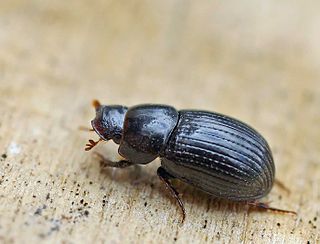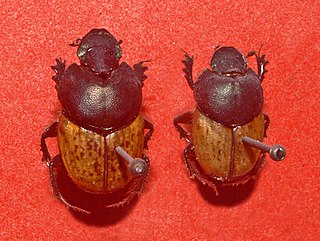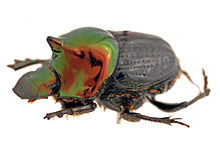
Bandipur National Park is a national park covering 868.63 km2 (335.38 sq mi) in Chamarajnagar district in the Indian state of Karnataka. It was established as a tiger reserve under Project Tiger in 1973. It is part of the Nilgiri Biosphere Reserve since 1986.
Colobonthophagus is a subgenus of scarab beetles in the genus Onthophagus of the family Scarabaeidae. There are more than 30 described species in Colobonthophagus. They are found in the Palaearctic and Indomalaya.

Furconthophagus is a subgenus of scarab beetles in the genus Onthophagus of the family Scarabaeidae. There are more than 20 described species in Furconthophagus. They are found mainly in Africa, Asia, and Europe.

Onthophagus is a genus of dung beetles in the Onthophagini tribe of the wider scarab beetle family, Scarabaeidae. It is the most species-rich and widespread genus in the subfamily Scarabaeinae, with a global distribution.
Onthophagiellus is a subgenus of scarab beetles in the genus Onthophagus of the family Scarabaeidae. There are more than 20 described species in Onthophagiellus. They are found primarily in Asia and Africa.
The Australian Dung Beetle Project (1965–1985), conceived and led by Dr George Bornemissza of the Commonwealth Scientific and Industrial Research Organisation (CSIRO), was an international scientific research and biological control project with the primary goal to control the polluting effects of cattle dung.

George Francis Bornemissza was a Hungarian-born entomologist and ecologist. He studied science at the University of Budapest before obtaining his Ph.D. in zoology at the University of Innsbruck in Austria in 1950. At the end of that year, he emigrated to Australia. There he first worked in the Department of Zoology at the University of Western Australia for 3 years, before pursuing a career with the Commonwealth Scientific and Industrial Research Organisation (CSIRO). Bornemissza was known for his work on the Australian Dung Beetle Project (1965–1985) while working at CSIRO's Division of Entomology. He wrote scientific papers and books based on his research and contributed a collection of mounted beetle specimens to the Australian National Insect Collection and the Tasmanian Museum and Art Gallery. In 2001 he was awarded the Medal of the Order of Australia for his services to Australian entomology.

Digitonthophagus gazella is a species of scarab beetle. It belongs to the genus Digitonthophagus, which was promoted from subgenus to genus level in 1959. There has been some confusion regarding the application of the names with many people using the outdated name Onthophagus gazella. Dung beetle experts use the term Digitonthophagus gazella.

Onthophagus taurus, the taurus scarab, is a species of dung beetle in the genus Onthophagus and the family Scarabaeidae. Also known as the bull-headed dung beetle, it is a species that specializes in cattle dung and is widely utilized to maintain clean pastures, making it agriculturally valuable. These beetles are typically 8–10 millimetres (0.31–0.39 in) in size. The males of this species exhibit distinct characteristics: large “major” males possess long, sweeping, curved horns resembling those of a longhorn bull, while small “minor” males have tiny horns that project upward from the back of their heads. Females, on the other hand, lack horns. These small beetles are oval shaped, the color is usually black or reddish brown. Sometimes the pronotum has a weak metallic sheen.

Onthophagus vacca is a species of dung beetles in the Onthophagini tribe of the wider scarab beetle family, Scarabaeidae.

Onthophagus nuchicornis is a species of dung beetle in the family Scarabaeidae. It is found in Europe and North America. Though Onthophagus nuchicornis is listed as "Vulnerable" in the United Kingdom, it is a common and abundant species in North America. It has been used as a model organism for ecotoxicological studies of ivermectin, where different biological endpoints are stimulated at low levels of ivermectin exposure, but impaired at high levels of ivermectin exposure.
Onthophagus pennsylvanicus is a species of dung beetle in the family Scarabaeidae. It is found in North America.
Onthophagus concinnus is a species of dung beetle in the family Scarabaeidae.
Onthophagus ceylonicus, is a species of dung beetle found in India and Sri Lanka.
Onthophagus fuscopunctatus, is a species of dung beetle found in India, and Sri Lanka.
Onthophagus ludio, is a species of dung beetle found in India, and Sri Lanka.
Onthophagus negligens, is a species of dung beetle found in India, and Sri Lanka.







